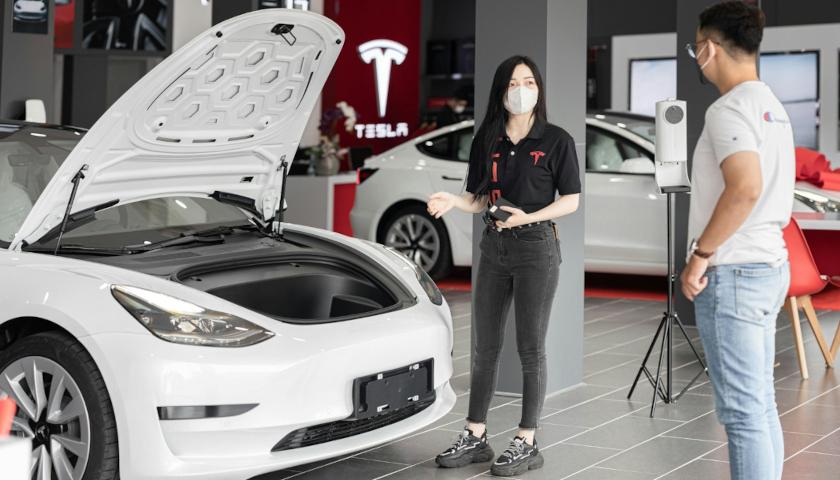by Kevin Killough
Between safety and reliability issues, as well as a dearth of charging stations, electric vehicle owners have been having quite a bit of buyer’s remorse, and now they may have another reason to go back to gas cars — EVs are rapidly depreciating.
Rental company Hertz announced in 2021 it would buy 100,000 EVs from Tesla, only to find lackluster interest from renters. In January, the Hertz announced it was selling off 20,000 of the vehicles, with prices as low as $25,000. Vehicle depreciation cost the company $588 million in the first quarter of this year compared to the last quarter of 2023.
Zach Shefska, chief executive officer for CarEdge, explains in a video that depreciation of Teslas are sometimes double that of gas-powered vehicles, based on CarEdge’s latest figures. The data shows that a Tesla Model 3 will depreciate 45 percent after three years. A gas-powered Toyota RAV4, for comparison, will depreciate 22 percent after three years. The resale value of the Tesla Model 3 after one year of ownership, according to CarEdge, is only 64.38 percent of its purchase price.
It’s not much better for other Tesla models. The Tesla Model Y, Model S, and Model X will depreciate 57 percent after five years. For the RAV4, it’s 28 percent after five years.
Aaron Turpen, an automotive journalist who has test driven and written about many models of EVs, told Just The News that Tesla is running up against market saturation.
“You hit a certain point where there’s so many on the road that people just don’t want them anymore, because they see them all the time,” Turpen said.
He said a similar thing happened with the Toyota Camry back in the 1990s. The Tesla depreciation, he added, also slows down after the first year to something comparable to its gas-powered counterparts.
“So they are depreciating very highly in the first year, but they are depreciating at the same or pretty close to the same level that luxury cars do. And since most electric cars are actually luxury cars, that makes sense,” Turpen explained.
A recent McKinsey & Company survey found that globally 3 out of 10 electric vehicle owners will likely switch back to a gas-powered vehicle with their next purchase. The primary reason for the EV owners’ dissatisfaction, according to the survey, is that public charging infrastructure is not adequate for their needs, a problem that’s likely to get worse.
Of those surveyed, only 4,000 were in the U.S., which means only about 1,840 people said they’d likely give up electric cars for their next purchase. That’s a small portion of the 2.5 million EV owners in the U.S., but there are EV owners who will be looking to get out of the EV world soon.
If they’re still paying off their car loans, they may be in for an unpleasant surprise. The depreciation rates are hurting owners of all car types, but EV owners find themselves deeper underwater when they go to trade in their cars. Data from Edmunds shows that 23.9 percent of new vehicle sales with a trade in had negative equity, which is the highest Edmunds had recorded since the first quarter of 2021.
The average amount owed where the owner’s balance on their loan exceeded the car’s worth, called “upside-down” loans, climbed to a record high of $6,255 in the second quarter of 2024, which was up from $4,487 in the second quarter of 2022.
For EV owners with upside-down loans, the negative equity hit $10,326 in the second quarter of this year, which was nearly double the $5,469 it was at in the second quarter of 2022.
“Over the last few years, inflated vehicle trade-in values kept consumers somewhat shielded from falling underwater on their car loans. As the market continues to correct and trade-in values normalize, this protection is falling away, with some vehicle types more affected than others,” Jessica Caldwell, Edmunds’ head of insights, explained in a statement.
Caldwell also noted these depreciation rates are normal for an emerging technology, and federal incentives for new EVs are lowering demand for used EVS, adding to the problem. Edmunds analysts advise consumers to avoid trading in their vehicles too soon, or buying used vehicles to offset some of the depreciation.
Shefska, with CarEdge, said that EV owners should check to see if they’re in a negative equity situation. If they are, he said, they should consider getting option Guaranteed Asset Protection (GAP) insurance. With standard insurance coverage, if your car is stolen or totaled, the insurance company will only pay what the vehicle is worth. If that’s less than the loan, the owner will have to cover the difference. With GAP insurance, that difference will be covered.
– – –
Kevin Killough is a reporter for Just the News.
Photo “Tesla Showroom” by Screen Post.





